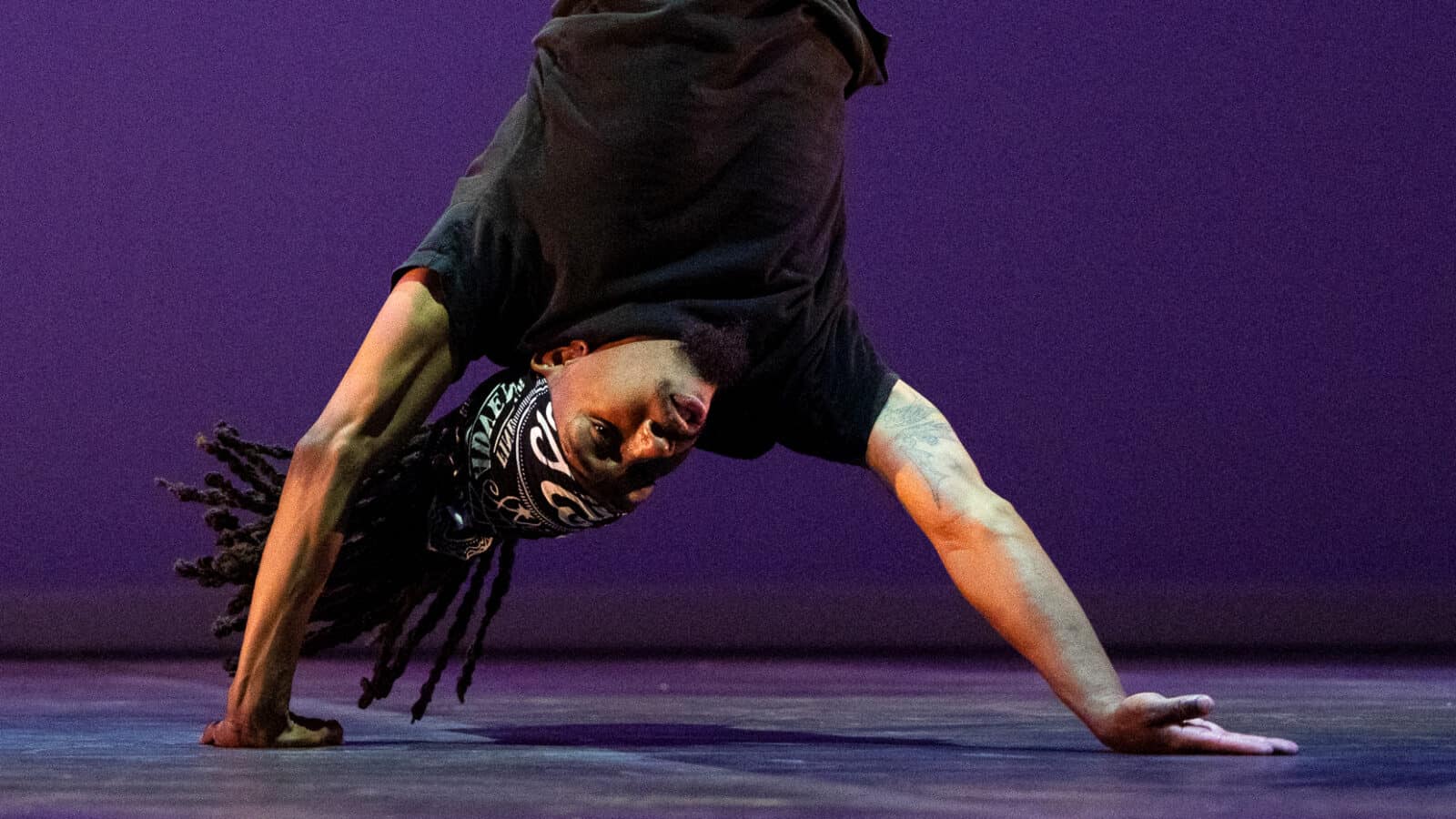A man spins and breaks, turning on one arm, holding his whole weight on one center of gravity and flipping across the stage as though his body is speaking a sadness and anger too great to say aloud or contain.
He’s kneeling next to a friend, trying to move him. And then he’s weeping, alone in a room where the light slants down as though through a window surrounded by buildings. Their movements hold a story, the sight and sounds and voices in a summer night with people at the center of your life — they can be bedrock and still vulnerable — and knowing that can leave you aware of how much they matter.
Joshua Colbreath and Phillip Cuttino perform in Rennie Harris’ Nuttin’ but a Word on the opening night of Hip Hop Across the Pillow, and they’re sharing one moment in a night that dives into deep feeling — community, loyalty, challenge and laughter and glorious comedy, as acrobatic as astronauts in in zero gravity.
This week, contemporary Hip Hop artists are celebrating the 50th anniversary of Hip Hop’s emergence in the Bronx in the 1980s. And as they tell us in Octavia Butler’s words, they are here to ‘make people touch and taste and know — make people feel.’
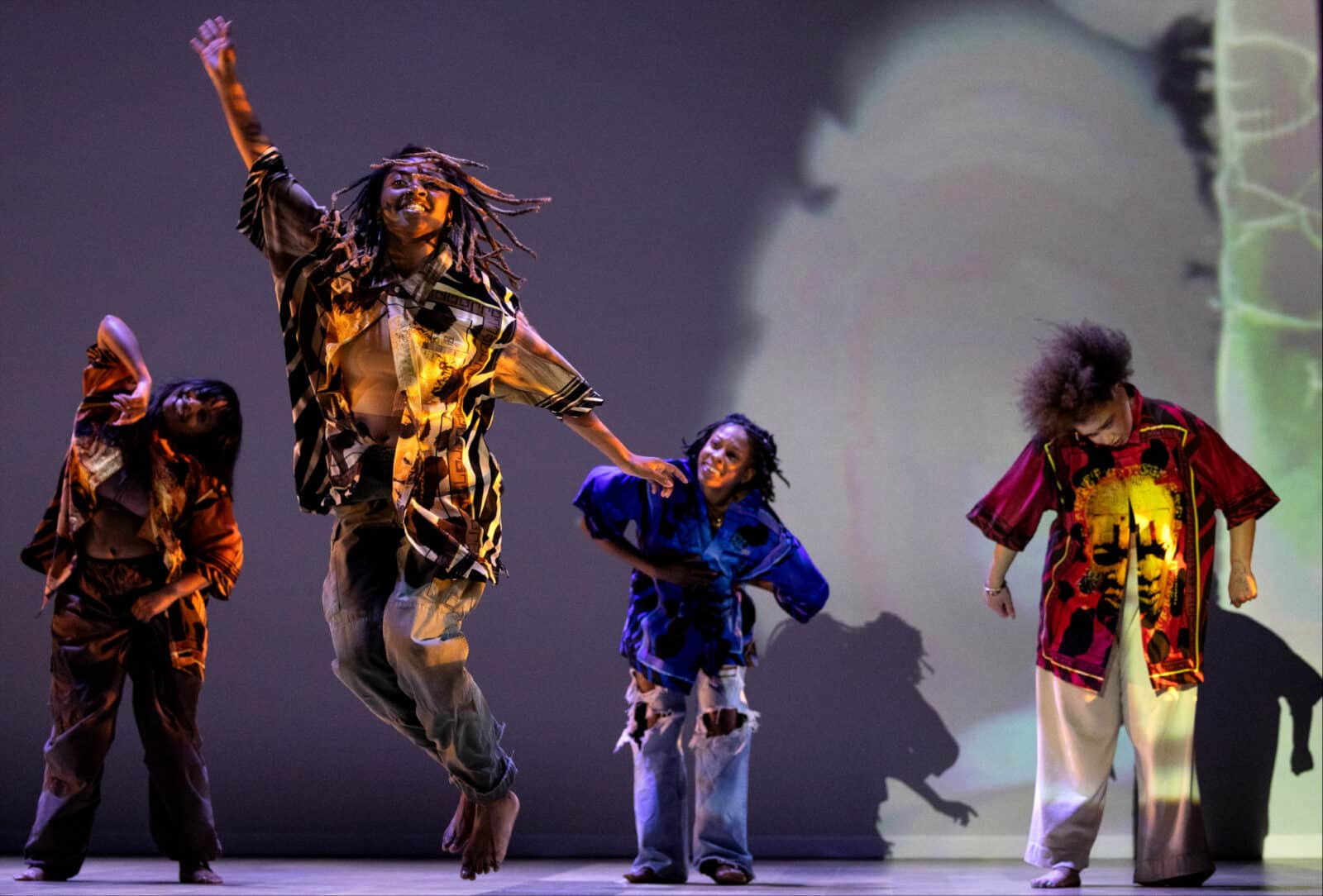
Ladies of Hip-Hop perform in d. Sabela Grimes' 'Parable of PassAge.' Press photo courtesy of Jacob's Pillow
They draw on words in her journal, as they draw on the voices of leaders in the movement, and on the movement of thousands of dancers and artists in thousands of circles across the country.
Hip Hop has roots in a place and time and community, says Pillow scholar in residence Dr. Imani Kai Johnson, and also in many people and places and neighborhoods. It comes from a wide culture and constellation of Black and Nuyorican artists, sharing cultures with Puerto Rico and New York.
A web of dance and music and spoken word has taken root in street corners and clubs and living rooms, says Jacob’s Pillow associate curator Ali Rosa-Salas, and has spread to cities and stages around the world.
As tonight opens, two thieves slip into a museum gallery. They’re competing for an element at center stage, an intense point of light. And they’re turning the narrative upside down, sometimes literally, with surreal brilliance. They’re dancing with flashlights, breaking to slide under the laser beams and turning the alarm system into a disco.

Kwikstep and Rokafella in perform in Thief of Hearts.' Press photo courtesy of Jacob's Pillow
Kwikstep and Rockafella perform a new Pillow Commission, Thief of Hearts. They’re melding a heist film and a dance battle, encountering each other with the dramatic challenge of silent film and Marvel comics.
They flip and skim through the shadows in fast and fluid movement, as though the pulse of the music travels through their bodies, Carib Leap and James Brown’s Give It Up and Turn It Loose.
The sound and imagery take me back to MTV music videos and high school dances. And then they see each other and whip off their face masks, a dramatic reveal as we see their faces too. They take gear from their packs and the lights turn off, and they’re wearing lights, headbands and glowsticks, dancing like a four-armed Kali.
They’re sparring for the stone — or for the source of light, since what we see them seeking is an intense glow. They’re trading moves and launching into headspins. He wins on the Capoeira and she wins on the heist, and then they carry the drama into the curtain call, playing the crowd, and the room is laughing with them.
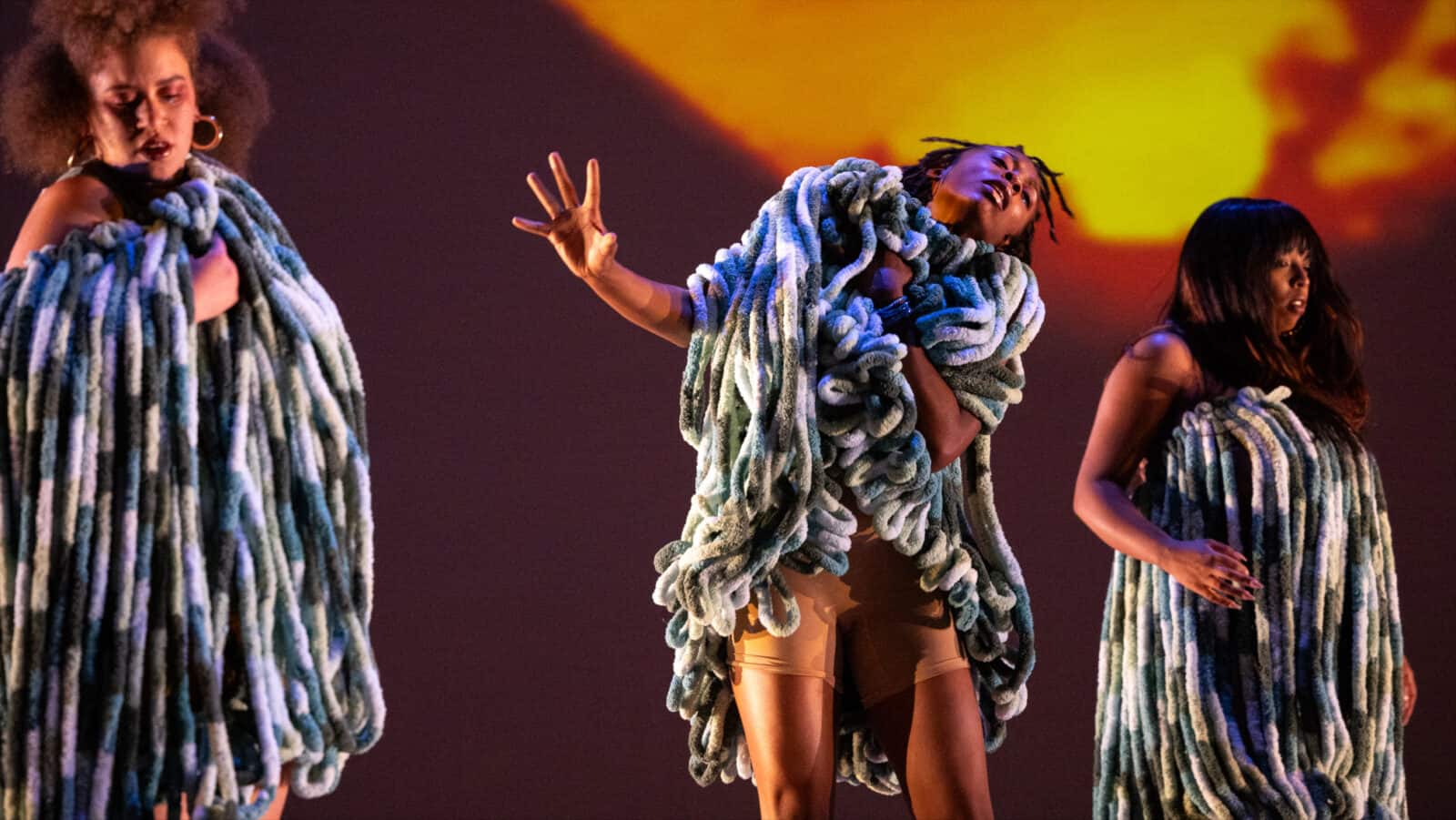
Ladies of Hip-Hop perform in d. Sabela Grimes' 'Parable of PassAge.' Press photo courtesy of Jacob's Pillow
And then the tone shifts. Across the lowered curtain, the word Starseed invokes Lauren Olamina’s philosophy of survival in Octavia Butler’s novel, Parable of the Sower.
Four women are dancing in bright loose tunics and trousers, carrying African inflections in red and yellow, flame amber orange and blue. They are pairing off, intimate and entwined, a phrase repeating. The Ladies of Hip Hop — Jai’Quinn Coleman, Reyna Núñez, Imani Arrington and Iman Brooks — are performing another Jacob’s Pillow commission, d. Sabela grimes’ Parable of PassAge.
This work forms part of a larger creative body, Sabela says in the program notes — Parable of Portals, a collection of poetry, transmedia film and music and improvisational movement, dreaming Octavia Butler’s writings into live performances.
Parable of the Sower begins in a time of collapse — economic, environmental, social. A community has been hanging on in Southern California, trying to grow their own food, teach their children and protect themselves from the thousands of people who have fallen apart in chaos.
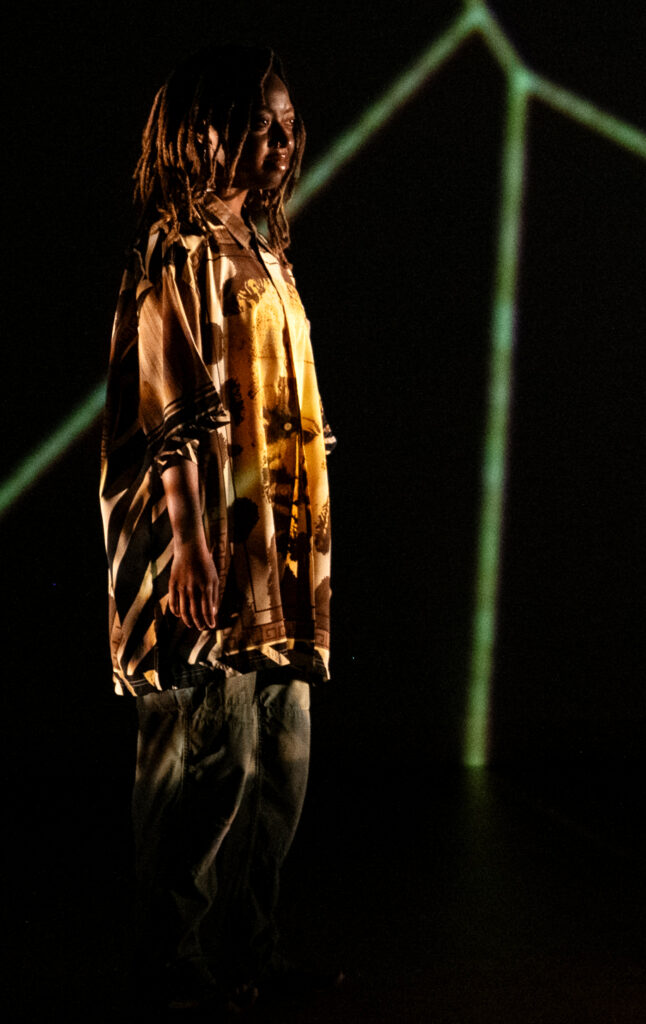

Imani Arrington, Reyna Núñez, and Jai’Quinn Coleman in d. Sabela Grimes’ ‘Parable of PassAge,” with the Ladies of Hip-Hop.’ Press photos by Cherylynn Tsushima, courtesy of Jacob’s Pillow.
But the tide is rising, and an 18-year-old woman, Lauren Olamina, is one of the few who has the courage to see the dangers and the intelligence, education, tools and sheer will to hold onto love and community and try to rebuild.
The women in the company are dancing to music and voices, and to light projections like organic forms, spider webs and cellular organisms. And then they are moving with the night sky. Around them Black women are floating in the stars, strong and beautiful with nebulae in their hair and galaxies on their skin. Skies dapple into leaf shadows, and the women are holding and held in acacia trees in the veld, in the canopy, the roots, the mycelia in the earth.
The dancers come on again wearing garments made of soft strands of cloth that can can hide and reveal their bodies at the same time, shades of blue like the filaments of a jellyfish or the froth on a wave.
They move with lithe intention to Lauren Olamina’s words.
All that you touch, you change.
All that you change changes you. …
God is change.
Wildfires are burning in California, as Olamina walks up the ruins of highways along the coast, heading north, gathering people who will stand together. We hear Butler’s voice, and we see her handwriting, her hands.
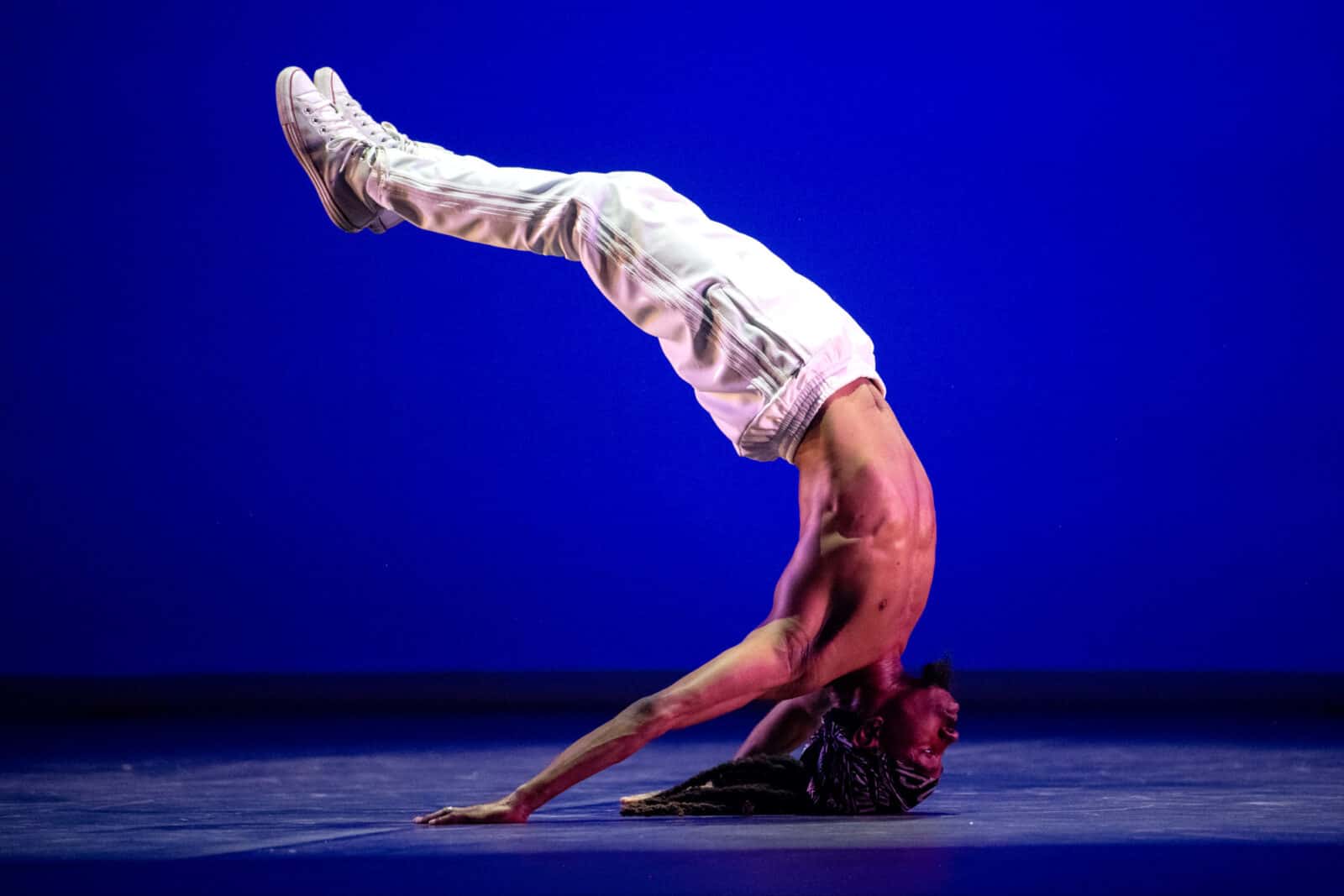
Joshua Culbreath arcs upside down in 'Nuttin' but a Word' with Rennie Harris Puremovement American Street Dance Theater. Press photo courtesy of Jacob's Pillow
A voice joins her from the center of the founding generation of Hip Hop — Rennie Harris is giving us three laws of Hip Hop Culture: innovation, individuality and creativity. His Puremovement American Street Dance Theater fills the second half of the program with Nuttin’ but a Word. The name, Harris says, means pay attention to what I’m about to do, because actions matter.
His company returns to the Pillow as they have many times over the past 25 years, and they have liftoff — they’re fast and flying, freestyling and improvising. They’re ramping up the friendly competition of the dancer in the circle, drawing energy from everyone around them. They’re intense and forceful, leaping high, tumbling and rebounding, propelling and propelled.
They’re glorying in the variety in the roots of the tradition. Hip Hop is growing from athletes, teenagers dancing to MTV music videos, as Rosa Salas and Johnson describe it — from rock and rap and R&B, music on the radio and boom boxes and record players.
It’s growing from the African diaspora and the Caribbean, moves and rhythms that came from seeds from cultures across Africa and the Americas and have survived and transformed for more than 400 years — and from New York pop culture before the internet existed.
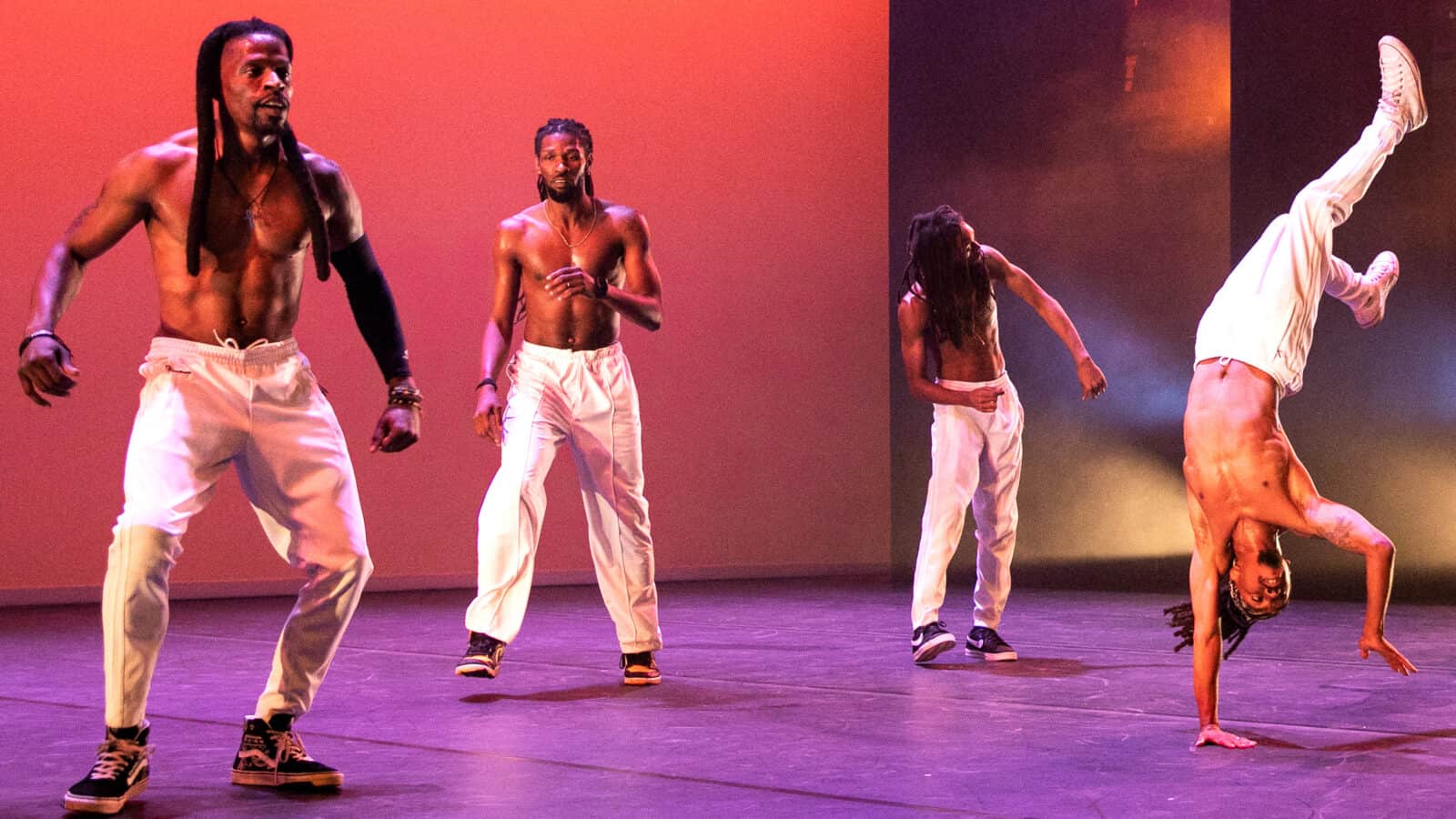
Performers in Rennie Harris' Puremovement American Street Dance Theater celebrate 50 years of Hip Hop. Press photo courtesy of Jacob's Pillow
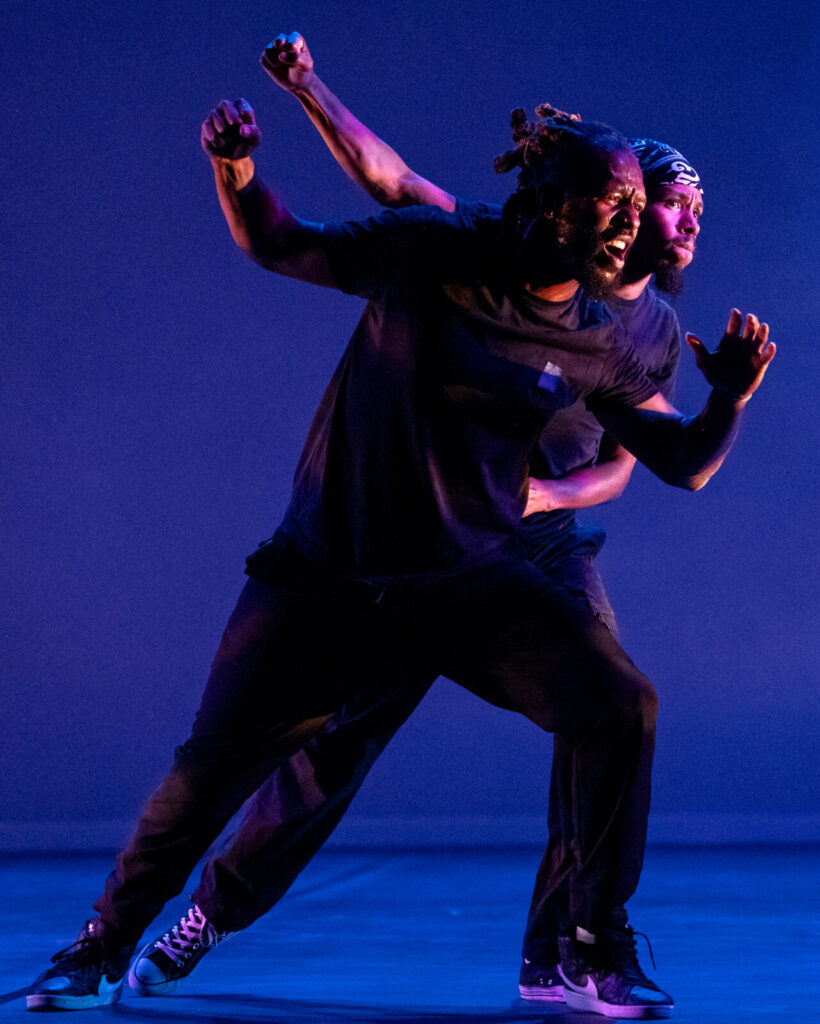

People come together to be with friends and feel safe. They meet in LGBTQ+ dances and clubs, on sidewalks and in parks, on steps and in kitchens, everywhere people live and look for community.
They dance the music, Johnson says. The audience is snapping and calling out, alive with pleasure in movement driven by the rhythm and the music — and by a strong individual strength of expression. Each dancer takes the stage in their own way. They can be buoyed by the group, and they can be independent. Angel Anderson holds the whole theater solo with the power of agile shoulders and open hands and speed.
They playing with the sound, talk back to it, content with it, decisive and definite, comic, playing the crowd. Their movements can become angular, almost clockwork, pushing a hip as though they need a hand to flip themselves, rotating joints as though they can spin an elbow 360 degrees.

Performers in Rennie Harris' Puremovement American Street Dance Theater celebrate 50 years of Hip Hop. Press photo courtesy of Jacob's Pillow
They weave in pop culture, voguing from poses on the fashion runway, popping to tense muscle as though a beat or a vibration runs through their body. The rhythm words of rap are an instrument and expression anyone can use. And they are dancing to songs, music and conversations.
Is this one of the powers at the heart of sampling — a tradition of sound that grows from consensus, a balance between one voice and a family of voices? This new generation of dancers are holding words in their bodies. They are honoring living keepers of knowledge and ancestors whose ideas are moving generations of people around the world. Harris says (on film and in his notes, as his company moves around him) that Hip Hop has to evolve, to live in new ways with each new generation.
Dance is ‘trickster, teacher, chaos, clay’ in Octavia Butler’s words. Dance exists to be shaped. Dance is change.

